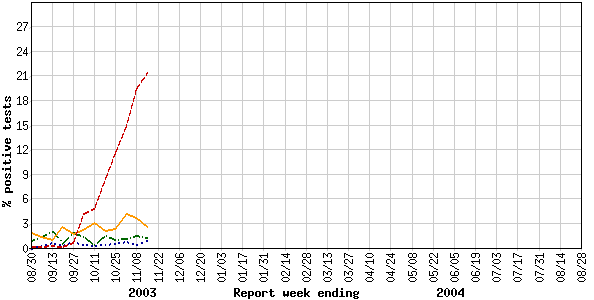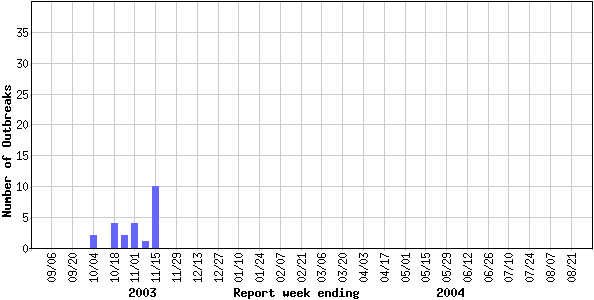|
|
|
Canada:
Widespread influenza activity is reported in all regions in Alberta
and Saskatchewan. Localized influenza activity is reported in two regions
of British Columbia and two regions of Manitoba. Sporadic influenza activity
is reported in two regions in British Columbia, two regions in Nova Scotia,
two regions in Ontario, one region in Manitoba and the Yukon in week 46. During
the week ending November 15 (week 46), sentinel physicians reported 34 cases
of influenza-like illness (ILI) per 1000 patient visits, which
is within baseline rates for week 46. During the one week period, November
9 to November 15, Health Canada received 1811 reports of laboratory tests
for influenza, including 388 (21.42%) influenza A detections and 0 (0%)
influenza B detections (see table). The National Microbiology
Laboratory has antigenetically characterized 69 influenza viruses to date;
43 A/Fujian/411/02(H3N2)-like,
25 A/Panama/2007/99(H3N2)-like and 1 A/New Caledonia/20/99(H1N1)-like. During
week 46, influenza outbreaks were reported in eight schools (seven in Alberta
and one in British Columbia), 10 LTC facilities (four in Alberta, three
in Saskatchewan, two in Manitoba and one in British Columbia) and four
lodges in
Alberta.
United
States:
During the week ending November 8, 2003 (week 45), one state (Texas) reported
widespread influenza activity, one state (Colorado) reported regional activity,
eight states reported local influenza activity and 22 states reported sporadic
activity. ILI visits accounted for 3.2% of patient visits to sentinel physicians,
which is above the national baseline of 2.5%. Sentinel cities reported that
6.2% of deaths were attributed to pneumonia and influenza, which is below
the epidemic threshold of 7.1% for this week. During week 44, the CDC received
1,056 reports of influenza tests and 203 (19.2%) were positive. Thirty influenza
A (H3N2) and 170 unsubtyped influenza A viruses and three influenza B viruses
were identified.
CDC: <http://www.cdc.gov/ncidod/diseases/flu/weekly.htm>
International:
WHO: Since the beginning of October, outbreaks of influenza in a number of
countries in Europe and North America have been due largely to A(H3N2) viruses.
Influenza activity has continued to increase during November in Finland,
France, Israel, Norway, Portugal, Spain, the UK and the USA. In Europe, most
H3N2 viruses that have been characterized antigenically so far this season
were A/Fujian/411/2002-like; in the UK, 2/3 of isolates characterized so
far were A/Fujian/411/2002-like and one third were A/Panama/2007/99-like.
In the US, more than 3/4 of the A(H3N2) isolates were A/Fujian/411/2002-like;
the rest are A/Panama/2007/99-like. The new drift variant A/Fujian/411/2002-like
virus is related to the A/Panama/2007/99(H3N2)-like strain included in the
current vaccine and antibodies induced against this vaccine strain cross
react with A/Fujian/411/2002-like strains, but generally at a reduced level.
It is expected that the current season’s influenza vaccine will provide
cross protection for the A/Fujian/411/2002-like variant but the degree of
protection is unknown.
EISS: In week 46, EISS is reporting widespread influenza activity in western
Europe and low or no activity in central Europe.
WHO: <http://rhone.b3e.jussieu.fr/flunet/www/index.html>
EISS: <http://www.eiss.org>
|

Total number of influenza tests
performed and number of positive tests by province/territory of testing
laboratory, Canada, 2003-2004
Province
of
reporting
laboratories |
Report
Period:
November 9 - November 15, 2003 |
Season
to Date:
August 24, 2003 - November 15, 2004 |
Total #
Influenza
Tests |
# of
Positive Tests |
Total #
Influenza
Tests |
# of
Positive Tests |
| Influenza
A |
Influenza
B |
Total |
Influenza
A |
Influenza
B |
Total |
| NL |
3 |
0 |
0 |
0 |
29 |
0 |
0 |
0 |
| PE |
0 |
0 |
0 |
0 |
6 |
0 |
0 |
0 |
| NS |
21 |
0 |
0 |
0 |
122 |
1 |
0 |
1 |
| NB |
-
|
-
|
-
|
-
|
88 |
0 |
0 |
0 |
| QC |
145 |
1 |
0 |
1 |
1406 |
1 |
1 |
2 |
| ON |
356 |
14 |
0 |
14 |
3236 |
21 |
0 |
21 |
| MB |
104 |
6 |
0 |
6 |
544 |
7 |
0 |
7 |
| SK |
342 |
211 |
0 |
211 |
2340 |
615 |
0 |
615 |
| AB |
684 |
129 |
0 |
129 |
4849 |
653 |
0 |
653 |
| BC |
156 |
27 |
0 |
27 |
524 |
50 |
1 |
51 |
| Canada |
1811 |
388 |
0 |
388 |
13144 |
1348 |
2 |
1350 |
|
Specimens from NT, YT, and NU are sent to reference laboratories in
other provinces.
Note: Cumulative data includes updates to previous weeks; due to reporting
delays, the sum of weekly report totals do not add up to cumulative totals.
Abbreviations: Newfoundland/Labrador (NL), Prince Edward
Island (PE), New Brunswick (NB), Nova Scotia (NS), Quebec (QC), Ontario
(ON),
Manitoba (MB), Saskatchewan (SK), Alberta (AB), British Columbia (BC), Yukon
(YT), Northwest Territories (NT), Nunavut (NU)
Respiratory virus laboratory detections in Canada, by geographic regions,
are available weekly on the following website:
<
http://www.phac-aspc.gc.ca/bid-bmi/dsd-dsm/rvdi-divr/index.html>

Number of influenza surveillance
regions† reporting widespread or localized influenza activity, Canada,
by report week, 2003-2004 (N=52)


† sub-regions within the province or territory as defined by the provincial/territorial
epidemiologist. Graph may change as late returns come in.


Influenza tests reported and percentage
of tests positive, Canada, by report week, 2003-2004



Percent positive influenza tests,
compared to other respiratory viruses by reporting week, Canada, 2003-2004



Influenza strain characterization,
Canada, cumulative, 2003-2004 influenza season by the Respiratory Viruses
Section at the National Microbiology Laboratory
[N=69]

NACI recommended components of the 2003-2004 Canadian vaccine include:
an A/New Caledonia/20/99 (H1N1)–like virus, an A/Panama/2007/99 (H3N2)-like
virus and either a B/Hong Kong/330/2001-like or B/Shangdong/7/97-like virus. Note:
the influenza A(H1N2) virus strain is a reassortment virus derived from
the influenza A (H1N1) and A(H3N2) virus strains. This strain circulated
widely during the 2001-2002 season and like last season the current vaccine
is expected to provide protection against this virus.
See http://www.phac-aspc.gc.ca/publicat/ccdr-rmtc/03vol29/acs-dcc-4/index.html

Influenza-like illness (ILI) reporting
rates, Canada, by report week, 2003-2004 compared to 1996/97 through 2002/2003
seasons


Note: No data available for mean rate in previous years
for weeks 21 to 39 (1996-1997 through 2002-2003 seasons). During weeks 20-39,
2002-2003/ 2003-2004 seasons, ILI is reported once every two weeks, on even
weeks only

Number of Outbreaks in Long Term
Care Facilities by Report Week, Canada, 2003-2004



|





